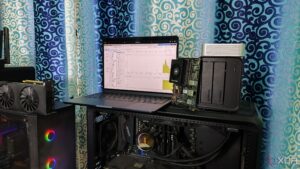
UPDATE: Anthropic has officially overtaken OpenAI as the leading provider of Large Language Models (LLMs) for businesses, capturing a remarkable 32% of enterprise usage. This significant shift, confirmed by Menlo Ventures, positions Anthropic at the forefront of the AI landscape as of July 2025.
This development is crucial for businesses globally, as AI continues to transform industries, particularly through programming applications. With Anthropic’s Claude models gaining traction, the company is redefining how enterprises utilize AI, highlighting the urgent need for organizations to adapt and integrate advanced AI solutions now.
According to Menlo Ventures, a prominent investor in Anthropic, the company achieved a staggering 1,000% year-over-year growth, reaching $3 billion in annual recurring revenue. This growth trajectory underscores the increasing reliance on Anthropic’s tools, especially in programming, where Claude has captured a dominant 42% market share, far surpassing OpenAI’s 21%.
“Anthropic has established itself as the premier enterprise AI company through its Claude family of LLMs,” stated a representative from Menlo Ventures.
The rise of Anthropic is attributed to its innovative approach in AI development, particularly its use of reinforcement learning with verifiable rewards (RLVR). This method allows for binary feedback on model outputs, ensuring high-quality code generation, a critical factor driving its success among developers.
In contrast, OpenAI and other competitors trail behind, with OpenAI holding 25%, Google at 20%, and Meta Llama with 9%. The stark difference highlights the shifting dynamics in the AI sector, where performance, rather than price, is the primary motivator for businesses switching LLMs.
Menlo Ventures’ findings indicate that the demand for high-performing models is skyrocketing, with 74% of startup builders reporting that their workloads are now primarily in production. Large enterprises are not far behind, with 49% indicating similar trends. This shift signifies that companies are not just experimenting with AI; they are actively implementing it to drive business outcomes.
Despite the emergence of new open-source models, they account for only 13% of AI workloads today, down from 19% six months ago. This decline suggests that while there are benefits to customization and cost, the performance of proprietary models like Anthropic’s remains unmatched.
As the AI landscape evolves, the market remains unpredictable. “Predicting the future of AI can be a fool’s errand,” noted Menlo Ventures, emphasizing the rapid changes in model capabilities and costs. The question now looms: which foundational models will dominate the future of AI? Anthropic, OpenAI, Google, or others?
As enterprises continue to adapt and leverage AI technologies, this latest surge in Anthropic’s performance could have profound implications for business strategies worldwide. Stay tuned as we monitor these developments closely.





